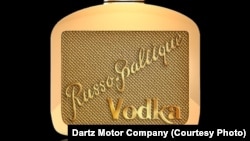The theft from a Danish bar of a bottle of vodka said to be worth $1.3 million has raised eyebrows around the world about the lavish spending habits of the nouveau riche in former Soviet republics.
Danish police say the rare -- and uninsured -- bottle of Russo-Baltique vodka was stolen in the early morning hours of January 2 from Cafe 33 in Copenhagen, which had a collection of 1,200 vodka bottles on display.
CCTV footage shows the thief using a flashlight in the darkness to single out the bottle and snatch it from the shelves of the collection -- the only item that was stolen from the establishment:
Investigators say they are still trying to determine whether the culprit broke into the vodka museum at Cafe 33 or used a key to carry out the theft.
Nouveau Riche, Big Spending
So why does a bottle of vodka cost $1.3 million, and who is willing to pay such an exorbitant sum?
Cafe 33 owner Brian Ingberg told Denmark’s TV2 that the bottle was on loan from the privately owned Riga-based Dartz Motor Company, which was founded by the Latvian-born businessman Leonard Yankelovich.
Dartz produced a limited number of the pricey bottles in 2008 and continues to build the world’s most expensive armored cars, primarily for the ultrawealthy in former Soviet republics, although oil-rich royalty from the Middle East also have bought Dartz vehicles.
Yankelovich told the BBC in 2015 that "luxury is too common a word" to describe Dartz cars or Russo-Baltique vodka because "luxury you can buy in a supermarket."
He said he prefers to use the word "opulence" to describe the company’s products, which are designed to stimulate the ostentatious spending habits of the richest of the rich in the former Soviet Union.
In this niche market, Dartz sells custom-built armored SUVs for prices that start at about $1.5 million.
Several Hollywood filmmakers have featured Dartz vehicles in their movies, including the Sacha Baron Cohen film The Dictator.
Ingberg reportedly told TV2 that the stolen bottle was one that replicated the shape of the front grill of a Russo-Balt automobile produced in Riga from 1908 to 1912.
Dartz was selling one of those bottles in 2008 for 1 million euros ($1.3 million).
It also was selling another bottle design in 2008, known as a Vodka Fire Extinguisher, for 500,000 euros ($650,000).
One of the Fire Extinguisher bottles was featured in an episode of the popular television series House Of Cards:
Both bottle designs were created in 2008 to mark the centennial of the Russo-Balt car company’s Riga factory -- a facility built when Riga was in the Russian Empire and where Dartz now has its workshops and offices.
A total of 625 Russo-Baltique vodka bottles were made, Dartz says. That’s the same number of Russo-Balt automobiles that were built at the Riga factory from 1908 until 1912, when the firm’s automobile production was moved elsewhere.
Russo-Baltique vodka bottles were designed to appeal to Russia’s nouveau riche -- described in 2009 by Russia’s then-Prime Minister Vladimir Putin as people who "all of a sudden got rich very quickly but cannot manage their wealth without showing it off all the time."
Indeed, the bottle stolen from Cafe 33 reportedly was fabricated using 3 kilograms of pure gold melted down from Tsar Nicholas II "chervonets" coins minted from 1908 to 1912 and 3 kilograms of pure silver.
The bottle cap was made from white and yellow gold and emblazoned on top with a diamond-encrusted Russian imperial eagle.
The centennial vodka project was financed by Regina Abdurazakova, who was described in Dartz’s promotional materials as "the extravagant daughter of an oil tycoon from Kazakhstan who decided to find a use for her father’s money."
"We can tell stories about special diamond filters or exotic products like whale spermaceti used in production of vodkas, but all this is beyond our understanding and so vague," Dartz says.
"This vodka brand is not for drinking because it is the brand of vodka to be received by succession," promotional materials say. "It is vodka that will be part of the family artwork collections. Why should we drink vodka that is regarded as an artwork?"
UPDATE: Danish police said the bottle was found intact, but empty, on January 5 at a villa that was undergoing renovation on the north side of the Danish capital.












